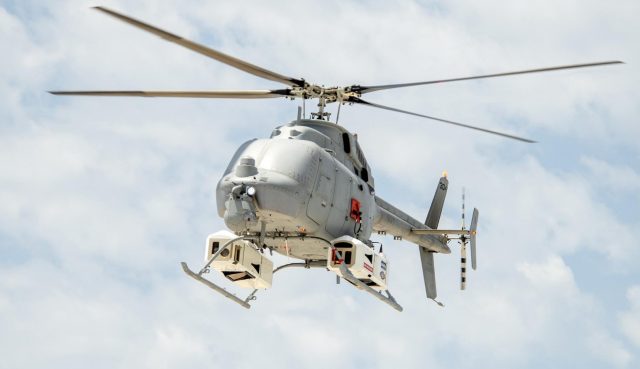
The US Navy revealed it has completed a demonstration of a new mine countermeasure (MCM) prototype technology aboard the MQ-8C Fire Scout UAS at Eglin Air Force Base, Florida.
The technology flown by the MQ-8C is known as the Single-system Multi-mission Airborne Mine Detection (SMAMD) system, and could provide the service with a capability for rapid detection and response to threats.
The objective of the demonstration was to gather performance data for both the MQ-8C and SMAMD to inform future MCM integration efforts.
“The team successfully demonstrated that the prototype SMAMD System effectively operates as designed aboard the MQ-8C Fire Scout unmanned helicopter in relevant real world environments,” said Capt. Thomas Lansley, Fire Scout program director. “This cutting-edge technology could really enhance Fire Scout’s capability going forward.”
The team conducted operations from the Naval Surface Warfare Center (NSWC) utilizing drifting, tethered, and moored mines throughout beach zone to deep waters. They gathered data day and night, across all water depths and in mild to difficult weather conditions.
The demonstration also proved the performance of the MQ-8C Fire Scout. The navy said the air vehicle handled the dual podded system with ease, being the first MCM capability flown on the MQ-8C as well as the heaviest payload carried to date. Fire Scout successfully operated in restricted and unrestricted air space alongside other aircraft platforms.
The SMAMD system, developed by BAE Systems under a Future Naval Capability (FNC) program sponsored by the Office of Naval Research (ONR), is an airborne optical sensor suite that, in a single pass, detects and localizes mines and obstacles on land and at sea. With a low false-alarm rate, SMAMD provides real-time detection sent via data link enabling warfighters to respond much quicker to threats than the current MCM technologies allow as post-mission analysis is required.
This effort, led by ONR, included support from multiple organizations across the Navy and industry including the MQ-8 Fire Scout program office, the Program Executive Office Unmanned and Small Combatants (PEO USC), Naval Air Warfare Center Aircraft Division (NAWCAD), Aircraft Prototype Systems Division (APSD), Webster Outlying Field (WOLF), the Digital Analytics Infrastructure and Technology Advancement Group Prototyping, Instrumentation and Experimentation Department, and Air Test and Evaluation Squadron Two Four (UX-24).



























